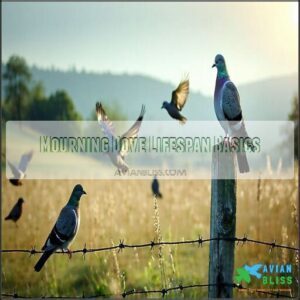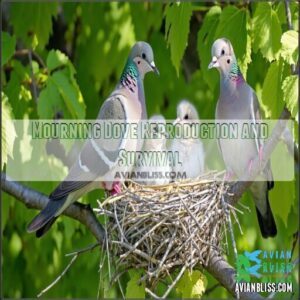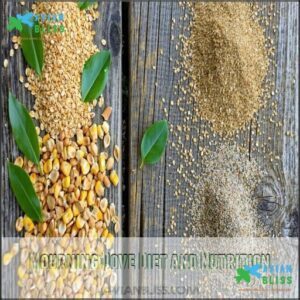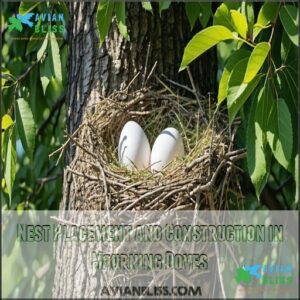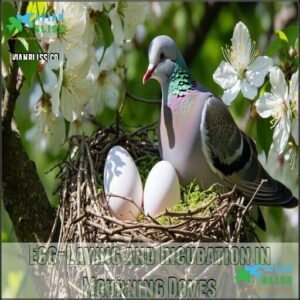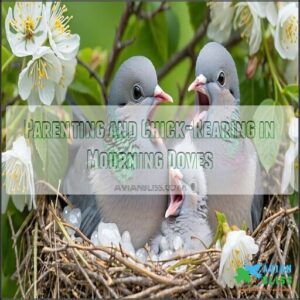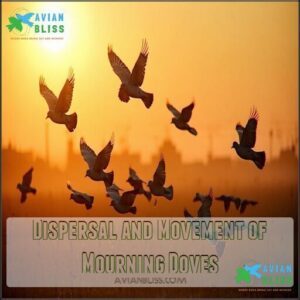This site is supported by our readers. We may earn a commission, at no cost to you, if you purchase through links.

Like many backyard birds, these gentle creatures face numerous threats that limit their lifespan, including predators, disease, and hunting.
In captivity, they’ve been known to reach an impressive 19 years! Despite their relatively short lives, mourning doves are remarkably prolific breeders, raising several broods annually—nature’s way of balancing their high mortality rate.
Their characteristic cooing might seem melancholy, but it’s actually part of their successful survival strategy that’s helped them thrive across North America.
Table Of Contents
- Mourning Dove Lifespan Basics
- Mourning Dove Mortality Rates
- Mourning Dove Reproduction and Survival
- Mourning Dove Diet and Nutrition
- Mourning Dove Habitat and Distribution
- Mourning Dove Behavior and Social Structure
- Mourning Dove Conservation Status
- Mourning Dove Nesting and Breeding
- Mourning Dove Migration and Movement
- Mourning Dove Interesting Facts
- Frequently Asked Questions (FAQs)
- How long do mourning doves live?
- What does a mourning dove look like?
- Do mourning doves sleep in pairs?
- Why do mourning doves die a year?
- Do doves survive?
- What is the shortest lifespan of a dove?
- Why is mourning dove lifespan so short?
- Do mourning doves return to the same nest every year?
- How long does a mourning dove live?
- How long do laughing doves live?
- Conclusion
Mourning Dove Lifespan Basics
Mourning doves generally live about 1 to 3 years in the wild, with most facing challenges like predators and disease.
Mourning doves lead brief but productive lives, cramming remarkable resilience into their short wild existence.
However, some can reach remarkable ages, especially in captivity, thanks to protection from natural threats.
Average Lifespan of Mourning Doves
The mourning dove lifespan is a balancing act between resilience and constant threats.
In the wild, their average dove lifespan is just 1.5 years, though the mourning dove age record reached an astonishing 31 years.
First-year mortality is brutal, with over half of juveniles failing to survive.
Despite predation effects and environmental impact, their adaptability helps populations thrive.
- Wild vs. Captivity: Captive doves can live over 10 times longer.
- First-Year Mortality: Over 75% perish early.
- Dove Life Expectancy: Typically under 2 years.
- Disease Influence: Significant in shortening lives.
- Dove Longevity: Rare cases exceed 30 years.
Factors Affecting Mourning Dove Lifespan
A bird’s life expectancy is shaped by predator impact, disease prevalence, and environmental challenges.
Hawks, foxes, and cats are constant threats, taking their toll on mourning dove survival. Disease spreads quickly in crowded nesting areas, reducing dove longevity.
Habitat quality also plays a role—urban sprawl eliminates trees and spaces where doves build simple twig-based nests.
Hunting pressure and lead poisoning are human-related dangers, while seasonal food shortages during weather extremes challenge their energy reserves.
Despite these trials, their resilience results in stable populations.
- **Did you know?
**Lead pellets from hunting areas often end up in ground-feeding birds like doves, severely harming their health.
Exceptional Longevity in Mourning Doves
Against all odds, some doves defy the short mourning dove lifespan of 1-3 years, reaching remarkable ages.
Against all odds, some mourning doves beat the survival curve, living 30+ years when luck, genetics, and environment align perfectly.
The longest-lived dove, tracked through banding, amazed researchers with a 31-year record.
In safe conditions, the captive dove lifespan can soar due to fewer predators and stable diets.
Here’s how environmental and genetic factors play a role:
| Factors | Impact on Lifespan |
|---|---|
| Genetic Predisposition | Extends natural lifespan |
| Diet Quality | Improves health |
| Predator Absence | Reduces mortality |
| Stable Climate | Prevents stress |
| Captive Environment | Increases longevity |
Understanding these bird lifespan factors reveals nature’s unpredictability!
Mourning Dove Mortality Rates
You might be surprised to learn that mourning doves face high mortality rates, with most not surviving their first year.
Predators, diseases, and environmental challenges all play significant roles in shaping their chances of survival.
Annual Mortality Rates of Mourning Doves
You might think mourning doves have it easy, but their mortality rates tell another story.
With over 60% of adults and up to 75% of juveniles lost yearly, survival is tough. Predators like hawks, owls, and outdoor cats dramatically affect their chances. Disease prevalence, including trichomoniasis and avian pox, compounds the challenge, while hunting effects add to annual losses.
Despite these challenges, their high reproductive rates maintain population stability. Like their relatives, they benefit from modern conservation laws.
- Predator impact: Vulnerable to ground-feeding dangers.
- Hunting effects: Millions harvested yearly.
- Disease prevalence: Common illnesses weaken survival.
Causes of Mortality in Mourning Doves
Predators like hawks, cats, and snakes severely affect the dove mortality rate.
Diseases, including trichomoniasis, and starvation from habitat loss escalate their risk.
Lead poisoning from ingested ammunition adds danger, alongside hunting effects and window collisions.
Ground-feeding behavior and environmental factors amplify their vulnerability.
Here’s a closer look:
| Threat | Impact |
|---|---|
| Predators | High mortality through predation |
| Disease Prevalence | Significant outbreaks (e.g., avian pox) |
| Starvation | Caused by scarce food sources |
| Lead Poisoning | Due to hunting debris ingestion |
| Hunting Effects | Increases direct mortality rates |
Human Impact on Mourning Dove Mortality
Humans play a significant role in mourning dove mortality through activities that disrupt their habitat and health.
Key factors include:
- Habitat Destruction: Urban threats like construction wipe out nesting and feeding sites, shrinking the mourning dove lifespan.
- Lead Poisoning: Feeding on lead shot remnants impacts their health, decreasing survival rates.
- Hunting Regulations: Although hunting mortality rates are regulated, millions are still harvested annually.
Supporting conservation efforts by planting native plants or reducing pesticide use can help these birds thrive.
Mourning Dove Reproduction and Survival
Mourning doves rely on high reproductive rates to offset their short lifespans, with pairs often raising multiple broods each year.
By building simple nests and sharing parenting duties, they guarantee their young have the best chance at survival despite numerous challenges, which is crucial for their survival due to their short lifespans.
Breeding and Nesting Habits of Mourning Doves
A mourning dove’s nesting habits highlight teamwork and devotion.
These birds choose their nest site thoughtfully, often favoring trees, shrubs, or even man-made structures. Their nests, crafted from twigs and grasses, may look simple yet serve their purpose well.
Mourning dove pairs show remarkable cooperation. Both parents share responsibilities during the incubation period, ensuring their clutch of two eggs is protected and warm.
After hatching, their diligent parental care boosts fledgling success by defending the nest and feeding nutritious "crop milk."
- Team effort: Both parents share incubation and feeding duties.
- Nest fidelity: Doves often reuse favored nesting spots.
- Diligent builders: Simple yet functional nests are swiftly constructed.
Clutch Size and Frequency of Mourning Doves
Mourning doves, with their high brood frequency, thrive as prolific breeders.
Each clutch usually consists of two eggs—occasionally three—with incubation shared by both parents over 14 days.
These small but determined birds manage up to 5-6 clutches per breeding season, ensuring their nesting success despite challenges in the wild.
Here’s a quick glance at their reproductive habits:
| Aspect | Details | Significance |
|---|---|---|
| Egg Number | 2 (occasionally 3) | Increases survival odds |
| Clutch Intervals | 5-6 per season | Enhances population recovery |
| Nesting Success | Cooperative care | Protects eggs from threats |
| Breeding Seasonality | Spring to summer | Optimizes ideal conditions |
| Lifespan Impact | High reproduction | Compensates for high mortality |
This continuous reproduction sustains their populations despite short lifespans.
Survival Rates of Mourning Dove Nestlings and Fledglings
Survival rates for mourning dove nestlings and fledglings often feel like flipping a coin. With mortality rates around 69%, challenges abound before fledging independence.
Nestling survival depends on factors like nestling predation, parental care, and food availability. Early fledging challenges can surprisingly increase their resilience.
Here’s why their journey is so risky:
- Nestling predation from cats, hawks, and snakes is a constant threat.
- Habitat influence affects food availability and shelter, essential for growth.
- Parental care improves survival, especially in two-parent nests.
- Disease impact like trichomoniasis reduces fledgling numbers.
Nature stacks the odds, but those that endure define future dove populations.
Mourning Dove Diet and Nutrition
You might be surprised to learn that a mourning dove’s diet revolves almost entirely around seeds, with some making up as much as 99% of what they eat.
Their unique feeding habits, like swallowing grit to help digest tough seed shells, play a vital role in their survival and overall health.
Primary Food Sources of Mourning Doves
Doves are expert seedeaters, meeting their nutritional needs through ground foraging.
Their dove diet includes seeds rich in energy and easy on crop digestion:
- Black-oil sunflower seeds for stamina.
- Millet for smooth digestion and essential nutrients.
- Cracked corn as a hearty filler.
They’ll even swallow grit while foraging, helping their crop grind seeds for better digestion.
A balanced diet can be achieved with a quality dove seed mix.
Importance of Seeds in Mourning Dove Diet
Seeds are the backbone of the dove diet, fueling their energy needs. As ground-seedeaters, these birds demonstrate remarkable foraging behavior by storing seeds in their crop.
Their seed preferences directly impact their survival, from energy-intensive reproduction to avoiding starvation.
| Seed Type | Nutritional Value | Dove Preference Level |
|---|---|---|
| Millet | High | Very High |
| Sunflower Seeds | Moderate | High |
| Cracked Corn | Moderate | Moderate |
| Wheat | Low | Low |
| Wild Grass Seeds | Moderate | Moderate |
Seed availability heavily influences mourning dove lifespan, as poor access can disrupt their diet.
Water Intake and Drinking Habits of Mourning Doves
Fresh water boosts hydration and supports the natural lifespan of mourning doves. Small birdbaths with shallow water mimic safe drinking spots.
Here’s how to help:
- Offer fresh water daily to meet hydration needs.
- Use shallow water sources to protect against drowning risks.
- Place baths near shrubs for shade and chick hydration.
Simple care helps reduce mortality rates!
If a dove is found on the ground, it may be experiencing signs of shock.
Mourning Dove Habitat and Distribution
You’ll find mourning doves across North America, from southern Canada to Mexico, thriving in diverse habitats including forests, grasslands, and urban environments.
They’re highly adaptable birds that don’t mind nesting near human activity, which explains why you’ve probably spotted them perched on telephone wires or feeding on seeds in your backyard, showcasing their ability to thrive in various settings, including urban environments.
Geographic Range of Mourning Doves
Three major zones across North America host mourning doves, from southern Canada through the continental U.S. into Mexico and Central America.
These adaptable birds enjoy a massive range spanning nearly 11 million km².
| Region | Status | Population Density |
|---|---|---|
| Canada | Summer breeding | Moderate |
| U.S./Mexico | Year-round | High (346 million) |
| Central America | Winter only | Variable |
Their range expansion continues as these resilient birds thrive in diverse North American habitats.
Habitat Preferences of Mourning Doves
Moving from their widespread geographic range, mourning doves select habitats that directly impact their lifespan. These adaptable birds thrive where food availability and water sources meet their needs.
Their natural habitat preferences strongly influence dove natural lifespan, with birds in suitable environments living substantially longer than those in compromised settings.
Ideal nesting locations for mourning doves include:
- Open woodlands with scattered trees for roosting sites
- Agricultural fields rich in seeds and grains
- Suburban areas with birdfeeders and consistent water access
Consider providing safe nesting locations to encourage doves in suitable environments.
Urban and Rural Distribution of Mourning Doves
Mourning doves’ habitat choices span both bustling cities and quiet countryside, with each environment offering unique survival advantages and challenges.
You’ll find these adaptable birds thriving in urban parks, residential backyards, and on building ledges, while their rural counterparts prefer open farmlands and woodland edges.
Their distribution directly impacts their lifespan, with urban doves facing window collisions and predator variation, while rural populations contend with different mortality rates from hunting and habitat availability.
Urban birds often display behavioral adaptations to thrive.
- Each environment shapes these resilient birds’ lives – whether dodging traffic in cities or finding abundant food sources in rural settings, which is a key aspect of their survival advantages and overall lifespan.
Mourning Dove Behavior and Social Structure
You’ll discover that mourning doves form strong pair bonds and mate for life, often returning to the same nesting sites year after year.
These social birds communicate through distinctive cooing calls and gather in small flocks when not breeding, creating complex social structures that help them survive despite their relatively short average lifespan of 1.5 years in the wild, which is a key factor in their social structures and overall survival.
Mating and Pair Bonding in Mourning Doves
In the context of love, mourning doves exemplify remarkable pair bond strength through lifelong monogamy.
Males perform elaborate courtship rituals, including gentle cooing and dramatic aerial displays to attract females.
Once mate selection occurs, these birds form powerful mating bonds that typically last for life, with very low divorce rates.
Their shared responsibilities in nesting and chick-rearing showcase how their monogamy duration contributes directly to their reproductive success.
Social Interactions and Communication in Mourning Doves
A mourning dove’s social language consists of gentle coos and deliberate movements that strengthen their community bonds.
You’ll notice these birds communicate through various cooing patterns – soft sounds that serve as warnings, mating calls, or parental instructions. Their vocal communication isn’t just pleasant to human ears; it’s essential for their survival and pair bonding.
When establishing relationships, mourning doves engage in elaborate courtship rituals like tail-fanning and bowing that signal interest and compatibility within their flock dynamics.
Here’s what makes their social interactions fascinating:
- Vocal repertoire includes at least five distinct calls with specific meanings
- Wing-whistling signals alert others to potential threats
- Social hierarchy influences feeding order and mate selection
- Mutual preening strengthens mating bonds between pairs
- Non-verbal cues like head-bobbing communicate intention without sound
Despite their generally peaceful nature, mourning doves occasionally display aggressive behavior when defending mates or competing for limited resources.
Roosting and Flocking Behavior of Mourning Doves
While communicating through soft coos and gentle movements, mourning doves also exhibit fascinating roosting behaviors as evening approaches.
You’ll find these birds gathering in communal roosts, where they display distinct flocking patterns for safety and efficiency.
Their preferred roosting locations include:
- Dense evergreen trees that offer protection from predators
- Areas close to reliable water sources
- Elevated perches with clear sightlines
Flock size typically increases during winter months, when these ground feeders form larger groups.
Their sleeping position—heads tucked under wings—conserves body heat while their social hierarchy maintains order within these peaceful gatherings.
They also establish a clear pecking order that minimizes conflict, ensuring a clear understanding of their place within the group, and promoting overall group harmony and efficient communication.
Mourning Dove Conservation Status
You’ll be glad to know that mourning doves maintain a healthy population of over 350 million across the United States, making them one of North America’s most abundant bird species.
Though they face threats from predators, disease, and habitat loss, their remarkable reproductive capacity helps maintain stable numbers throughout their wide geographic range.
Current Conservation Status of Mourning Doves
While social behaviors highlight their community nature, you’ll find the dove conservation status remarkably stable.
The IUCN classifies mourning doves as Least Concern with approximately 346 million birds in the US as of 2023.
| Conservation Metric | Current Status |
|---|---|
| Population Size | 346 million US |
| IUCN Status | Least Concern |
| Population Trend | -0.4% annually |
| Protection | Migratory Bird Treaty Act |
| Management | Three regional units |
Despite slight declines, bird conservation efforts maintain this abundant game bird’s population through balanced hunting regulations.
Threats to Mourning Dove Populations
Despite their stable populations, mourning doves face significant threats that impact their survival rates.
Understanding these challenges helps explain their typically short lifespans:
- Predator impact: Ground-feeding habits make mourning doves vulnerable to hawks, snakes, foxes, and domestic cats, resulting in high mortality rates, especially among young birds.
- Disease outbreaks: Trichomonas gallinae, avian pox, and various parasites commonly affect doves, with infected birds often dying from starvation as feeding becomes difficult.
- Environmental factors: Habitat loss through agriculture and urbanization reduces nesting sites, while lead poisoning from ingested shot pellets and climate threats like extreme weather events further stress populations.
These threats collectively contribute to why most mourning doves live only 1-2 years in the wild.
Conservation Efforts for Mourning Doves
While threats to mourning doves continue to grow, conservation efforts are making significant headway.
Banding programs throughout North America track population trends, while habitat preservation initiatives protect nesting sites.
Hunting regulations establish sustainable harvest limits, and disease mitigation strategies reduce outbreaks of trichomoniasis.
Public awareness campaigns highlight how you can help by creating bird-friendly spaces. You can also find a dove conservation guide for more information.
Through these bird conservation programs, you’re helping guarantee mourning doves remain a familiar sight in backyards nationwide.
Mourning Dove Nesting and Breeding
You’ll witness mourning doves building simple nests and forming lifelong partnerships that contribute to their reproductive success despite their short average lifespan of 1.5 years.
Their efficient breeding cycle includes 2-3 eggs per clutch with both parents sharing incubation duties, allowing these resilient birds to produce multiple broods annually.
This unique combination of traits enables the mourning doves to maintain their abundant population across North America.
Nest Placement and Construction in Mourning Doves
Mourning doves build their nests with remarkable precision, focusing on both safety and convenience. You’ll find their nests perched on sturdy branches 2-10 feet above ground, often near reliable food and water sources.
When constructing their homes, these birds use:
- Twigs and pine needles for a sturdy foundation
- Soft grasses and leaves for interior comfort
- Urban materials like string or paper in city environments
Dove nesting habits vary between urban and rural settings, with some pairs even reusing successful nesting sites or building in eaves troughs. They often prioritize shelter and safety when selecting these locations, and can be found near shelter and safety resources.
Egg-Laying and Incubation in Mourning Doves
After building their simple nest, the female mourning dove lays her precious cargo: typically two small, smooth white eggs per clutch.
You’ll find both parents committed to the 14-day incubation period, taking turns warming their developing offspring. This tag-team approach guarantees eggs are rarely left vulnerable to predators or weather.
- Clutch Size: Two eggs is standard, though rarely three may appear
- Egg Appearance: Glossy white, oval, measuring about 1 inch long
- Incubation Period: 14-15 days with constant coverage
- Parental Roles: Males typically sit from morning to afternoon, females take over for night duty
- Hatching Success: About 70% when undisturbed by predators
These dedicated parents may produce up to seven broods annually, demonstrating remarkable reproductive efficiency.
Parenting and Chick-Rearing in Mourning Doves
Nurturing new life, mourning dove parents exemplify dedicated coparenting after eggs hatch. Both adults work tirelessly to guarantee their nestlings survive those critical first days.
| Parental Role | Father Dove | Mother Dove |
|---|---|---|
| Incubation | Day shift | Night shift |
| Feeding | Produces crop milk | Produces crop milk |
| Protection | Guards nest | Guards nest |
| Teaching | Shows foraging | Shows flight skills |
You’ll notice both parents produce crop milk—a nutrient-rich secretion they feed to nestlings every 3-4 hours. This unique substance accelerates nestling development, helping babies grow rapidly.
As fledgling independence approaches, parents shift from feeding to teaching survival skills. This intensive brood survival strategy contributes substantially to the dove life cycle and ultimately impacts mourning dove breeding success.
Mourning Dove Migration and Movement
You’ll find that mourning doves display fascinating migration patterns as they travel between breeding and wintering grounds, with some populations moving over 1,000 miles seasonally.
Their movement is influenced by food availability and weather conditions, making them adaptable birds that you might observe in your backyard throughout changing seasons.
Others remain year-round residents.
Migration Patterns of Mourning Doves
While mourning doves tend to their families at nesting sites, many prepare for remarkable journeys across North America.
You’ll find these birds responding to specific migration triggers including changing daylight hours and food availability. They navigate established flyway routes at impressive speeds—sometimes covering up to 100 miles daily.
- Banding studies reveal that mourning doves from northern regions travel significant migration distances to reach southern wintering grounds, while some populations remain year-round residents based on local climate impacts.
Their migratory patterns directly influence their average 1.5-year lifespan in the wild.
Altitudinal Migration of Mourning Doves
While some birds travel thousands of miles during seasonal migrations, mourning doves often exhibit altitudinal migration instead.
As environmental factors change, these adaptable birds move up and down elevation gradients rather than across long distances.
Migration triggers for altitudinal movement include:
- Temperature shifts that signal breeding seasons at higher elevations
- Resource availability that varies with altitude throughout seasons
- Predator density that typically decreases at higher elevations
- Climate impacts such as snowfall that affect food accessibility
- Breeding altitudes that offer safer nesting opportunities
This elevation influence directly impacts mourning dove lifespan.
By relocating vertically rather than horizontally, they conserve energy while still accessing ideal seasonal conditions.
This strategic movement helps reduce mortality rates, particularly during harsh weather periods when resources become scarce at certain elevations, allowing them to conserve energy and find safer nesting opportunities.
Dispersal and Movement of Mourning Doves
While some mourning doves stay put, others undertake impressive journeys throughout their lifetime.
You’ll notice different movement patterns between age groups—juvenile dispersal typically covers greater distances as young birds establish their own territories, while adults show remarkable site fidelity.
Dispersal triggers include seasonal changes, food availability, and breeding opportunities.
Their movement patterns directly impact mortality rates and overall lifespan.
- Banding studies reveal migratory connectivity between summer and winter ranges
- Urban movement patterns differ from rural ones, with city doves traveling less
- Range expansion continues northward as climate patterns shift
- Juvenile dispersal typically occurs 3-4 weeks after fledging
- Bird mortality during migration contributes substantially to their brief 1.5-year average lifespan
Mourning Dove Interesting Facts
You’ll discover that mourning doves are fascinating creatures with unique characteristics, including their distinctive "co-ah, coo, coo, coo" call and remarkable ability to form lifelong bonds with their mates.
While most wild mourning doves live just 1.5 years on average, the oldest recorded individual survived for an exceptional 31 years after being banded in 1968.
Unique Characteristics of Mourning Doves
The dove’s gentle nature reveals itself through several remarkable traits.
You’ll spot their distinctive grayish-brown body with black spots on wings and a blue ring around brown eyes.
Unlike other birds, mourning doves can drink by sucking water like a straw without tilting their heads back.
| Feature | Impact on Lifespan |
|---|---|
| Crop milk production | Nourishes young birds |
| Monogamous bonds | Increases survival chances |
| Flight patterns | Whistling wings alert others |
| Water-sipping ability | Improves hydration efficiency |
Their swift, direct flight reaches 55 mph, helping them escape predators and potentially extending their average dove lifespan despite high mortality rates.
Their ability to drink water efficiently is a key factor in their hydration efficiency and overall survival, highlighting the importance of monogamous bonds in increasing their chances of survival.
Mourning Dove Calls and Vocalizations
Listen for the distinctive cooing sound that makes mourning doves famous.
Their bird communication system includes:
- Perch calls ("coo-OO-oo") from males seeking mates
- Nest calls between paired doves during nest building
- Wing whistles that warn others of danger during flight
- Alarm signals that alert flockmates to threats
- Female calls ("ohr ohr") made while sitting on nests
Acoustic analysis reveals these vocalizations aren’t just random noise—each carries specific call meaning in dove behavior.
Mourning Dove Ancestors and Evolutionary History
Beyond their distinctive calls, you’ll find the evolutionary story of mourning doves equally fascinating.
These birds share genetic ancestry with the extinct passenger pigeon within the broader pigeon family.
Fossil records trace their lineage back millions of years, showing how dove phylogeny evolved through various speciation events.
Unlike their turtledove cousins, mourning doves developed unique evolutionary adaptations specifically for North American environments.
Scientists studying pigeon differences have identified how these ground-feeding habits and physical characteristics emerged gradually, making today’s mourning doves perfectly suited to their widespread habitat.
Frequently Asked Questions (FAQs)
How long do mourning doves live?
You’ll find that mourning doves typically live 1-3 years in the wild, but they can reach up to 5 years.
In captivity, they’re quite remarkable, sometimes living into their 30s without predators around.
What does a mourning dove look like?
You’ll spot a mourning dove by its soft tan-gray plumage, slim body, and long, pointed tail.
It’s medium-sized with a small head, black spots on wings, and distinctive black eyes ringed with blue-gray skin.
Do mourning doves sleep in pairs?
Mourning doves sleep in pairs during mating season, sharing roosting duties with their mates.
You’ll often see them cuddled together on branches.
When not breeding, they’ll sleep in larger social groups of 20 to 50 doves instead.
Why do mourning doves die a year?
You’d think these birds were tough as nails, but they’re not.
Your backyard mourning doves often fall prey to hawks, cats, diseases like trichomoniasis, harsh weather conditions, and hunting pressures within their first year.
Do doves survive?
Yes, they do, but survival isn’t easy.
Predators, diseases, and environmental threats constantly challenge them.
If they make it past their first year, their odds improve, with some even reaching five years or more, and this can be seen as a significant milestone in their survival.
What is the shortest lifespan of a dove?
The shortest lifespan for a mourning dove is less than a year, as over 75% don’t survive their first year due to predators, diseases, and environmental challenges.
Survival often hinges on avoiding these early threats.
Why is mourning dove lifespan so short?
Life’s a battlefield for mourning doves—predators, diseases, and environmental hazards constantly threaten them.
Their ground-feeding habits, fragile nests, and high predation rates, especially in their first year, make survival an uphill climb, with environmental hazards constantly posing a threat.
Do mourning doves return to the same nest every year?
Mourning doves often reuse the same nest yearly if it remains intact and safe.
Their strong site fidelity means they’ll return to familiar spots, especially when predators or environmental changes haven’t disturbed the area.
How long does a mourning dove live?
Wild mourning doves usually live 1-3 years, with most not surviving their first year due to predators and disease.
In captivity, they can reach 10-30 years, thanks to protection from natural threats.
How long do laughing doves live?
Picture a serene sky where laughing doves glide gracefully—these birds typically live about 3 to 6 years in the wild.
With care in captivity, though, their lifespan can stretch up to 12 years.
Conclusion
Much like the fleeting beauty of a sunset, mourning doves remind us of nature’s delicate balance.
Their lifespan, typically 1-3 years in the wild, reflects the challenges they face from predators, disease, and human impact.
Yet, their prolific breeding guarantees their survival, making them a key part of ecosystems across North America.
Understanding how long mourning doves live helps you appreciate their resilience and the importance of protecting these gentle birds for future generations.
- https://www.cambridgeday.com/2022/10/22/mourning-doves-have-a-mortality-rate-to-cry-over-but-survive-better-than-passenger-pigeon-cousins/
- https://digitalcommons.morris.umn.edu/jmas/vol38/iss2/4/
- https://www.iowadnr.gov/media/6995/download?inline
- https://ecotox.oehha.ca.gov/species/birds-terrestrial-birds/columbiformes/mourning-dove-zenaida-macroura?page=1%20title=
- https://www.birdsandblooms.com/birding/bird-species/mourning-dove-lifespan/?srsltid=AfmBOoqtc8pWP5mDjpxGbDBbAiqMe-9FZ6LotsApkQ8q29wsYXR4zr2y

